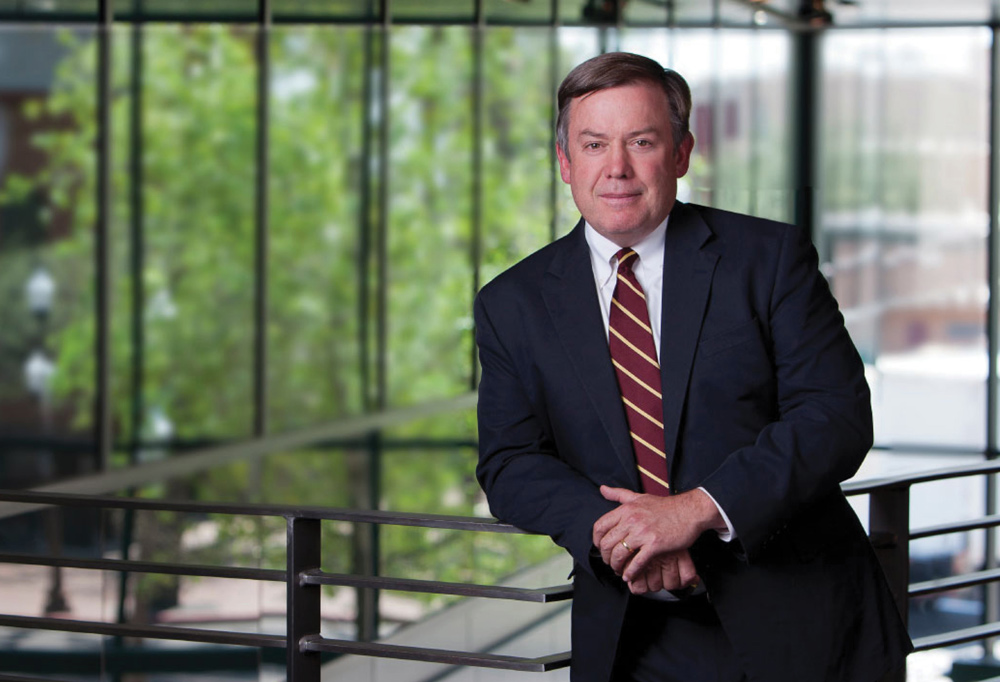W. P. Carey Turns 20


Carey, the chairman of the New York-based real estate investment firm W. P. Carey & Co., announced a $50 million endowment, which transformed the College of Business into the W. P. Carey School of Business and set the school on a transformative trajectory to become the largest and among the top-ranked business schools in the country.
The New York real estate investor had family ties to Arizona’s history and had already donated to ASU’s law school. His grandfather John S. Armstrong introduced the bill in Arizona’s Territorial Legislature in 1885 that established Arizona Territorial Normal School, which eventually evolved into ASU.
“Arizona State University, one of the leading public universities in the country today, has played an important role in the history of my family, and I am pleased that 118 years after its founding, I can stand here before you today in support of the university my grandfather helped create in 1885,” W. P. Carey said in a press release about the endowment on Jan. 28, 2003.
“It was such an exciting time,” says Anne Nguyen, then assistant dean of finance. “It was a great way to recognize our school and what we had accomplished to date with such little funding and to be able to launch us into that top 30 rankings consistently.”
“I always saw the gift as part of this signal that Mr. Carey recognized the trajectory we were on—that we were aspiring for higher and higher quality and that he could help us get there,” says Dennis Hoffman, then associate dean of graduate programs.
“What it did was provide us an opportunity to grow toward a world-class organization in terms of academic programs and experiences for students,” says Kay Faris, then assistant dean for undergraduate programs.
The W. P. Carey Foundation gift, celebrating its 20th anniversary this year, is a story of intentional philanthropy, strategic vision, teamwork, and the power of education.
Dean of W. P. Carey from 2004 to 2013
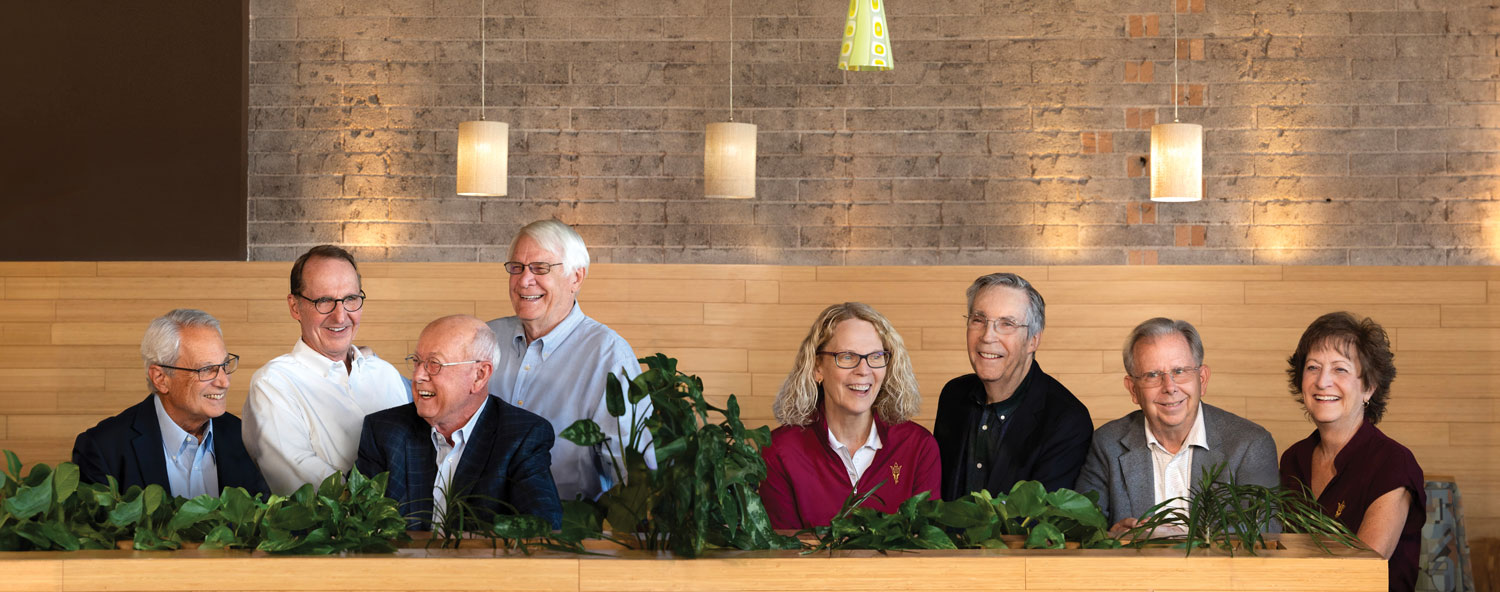
Laying the groundwork
The school developed a strategic plan that would take advantage of its strengths. “We had a distinguished accounting program, along with burgeoning information systems and supply chain management programs and the beginnings of a services marketing program,” Penley explains. “I was looking at where we could have distinguished elements of the school that you could build on.” The MBA program began offering specializations in supply chain management and services marketing at the beginning of its transformation.
Because rankings and reputation depended heavily on the quality of a school’s full-time MBA program, a major goal was improving and advancing that program. “We were known as having a large undergraduate business school, and we wanted a transformation,” says Lee McPheters, then associate dean for executive and professional programs. “We wanted to be a leading business school, and a leading business school has as its flagship the MBA.”
Students had goals, too. For Stephanie Maderazzo-Hughes, who graduated in 1999 with a bachelor’s degree in finance, it was getting a solid grounding in business. “My goals at the time were to learn about business and running a business, understanding all the different facets of it,” she says. “It was more about getting a good foundation and structure.”
The full-time MBA program got serious attention because of such programs’ role in signaling a business school’s quality. McPheters and Hoffman revised the curriculum to fit students’ objectives and made sure they had the faculty to deliver it. McPheters started publicizing the MBA program nationally to enlarge the pool of applicants and attract high-quality students. He worked on delivering what he called “a leading business school experience,” raising the quality of the orientation and the number of guest speakers, bringing students together for social activities, and organizing a separate MBA graduation ceremony.
They learned from other schools that top MBA programs emphasized the student experience and required the best possible faculty.
“It was a long process to turn the faculty into an MBA team,” McPheters says. “We had countless meetings, worked with the department chairs, and faculty dedicated to the MBA worked hour after hour on how we would integrate the courses.”
For the second-year tracks, they emphasized specializations that would attract recruiters and yield high placement rates and salaries for graduates.
The school’s master’s degree programs all became lockstep, wherein each student started and finished simultaneously, rather than taking a course here and another there. Services and tuition increased, establishing a high-quality brand at a reasonable price.
While these ambitious goals were on Penley’s mind, the naming proposal wasn’t when he walked into a friend’s Christmas party in 1995 and met Carey. The two hit it off, and Carey began inviting Penley to company events in New York and London.
During the same period, business students constituted the largest share of students in Barrett, The Honors College. “We began to hear from recruiters that our Barrett business students did as well or even better than students from more recognized schools,” says Steve Happel, then associate dean for undergraduate programs.
“I saw Bill Carey as the potential donor who could name the school, but I needed to impress him that our business undergraduates were of the same high quality as those from eastern schools like Wharton and Princeton,” Penley explains. “I asked him to interview our students for intern positions in New York. Of course, Steve and I focused on our business honors students as the interviewees. And W. P. Carey hired several of them.”
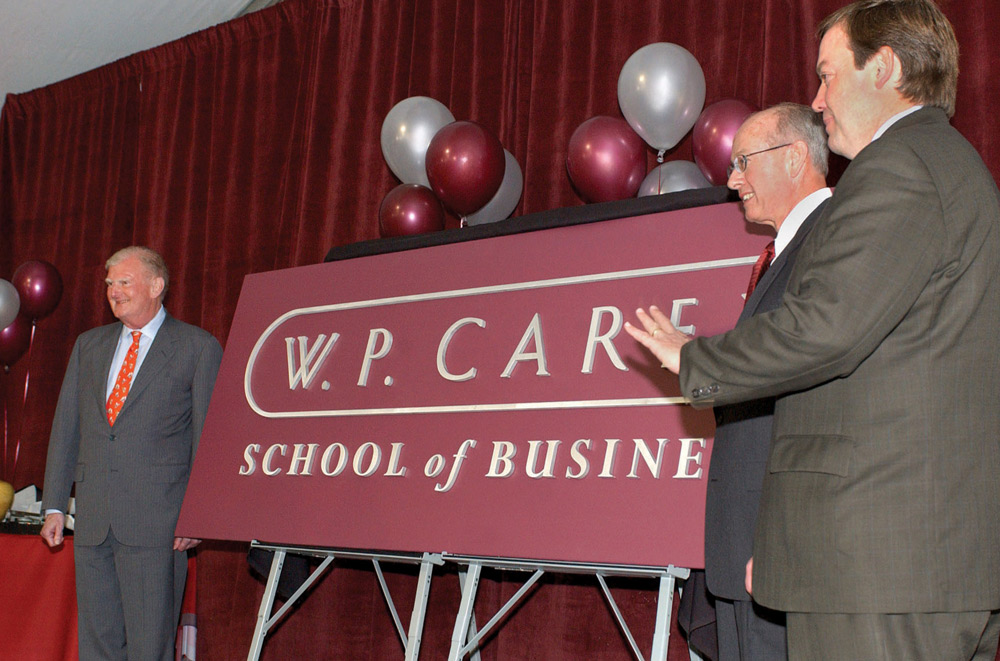

“I believe the key to future economic growth of our country is to provide a quality education to our young,” Carey said in announcing the endowment. “The W. P. Carey School of Business will be dedicated to producing the top entrepreneurs and business leaders of the 21st century and beyond. I have great respect for President Michael Crow and Dean Penley, and I am pleased to offer my support as they continue to build one of the top universities in the country.”
Beginning the transformation
Robert E. Mittelstaedt Jr., dean of the school from 2004 to 2013, says the best business schools admitted top students to a business track as first-year students rather than delaying the decision until two years of successful study as many state schools do.
So for undergraduates, the school decided to preadmit high achievers to all four years of business education. Students not admitted as first-year students could also be admitted later based on performance in their first two years. Faculty and administrators also recognized that many undergraduate students wanted the basics of business to complement their other studies. They created a Bachelor of Arts degree in business, an interdisciplinary degree with other colleges that Faris says proved “wildly popular.” Faculty members helped develop the BA curriculum, and to teach it, the school enlisted those who loved students and could energize large classes. Students would take the core and required business curriculum courses, as well as courses in their desired fields.
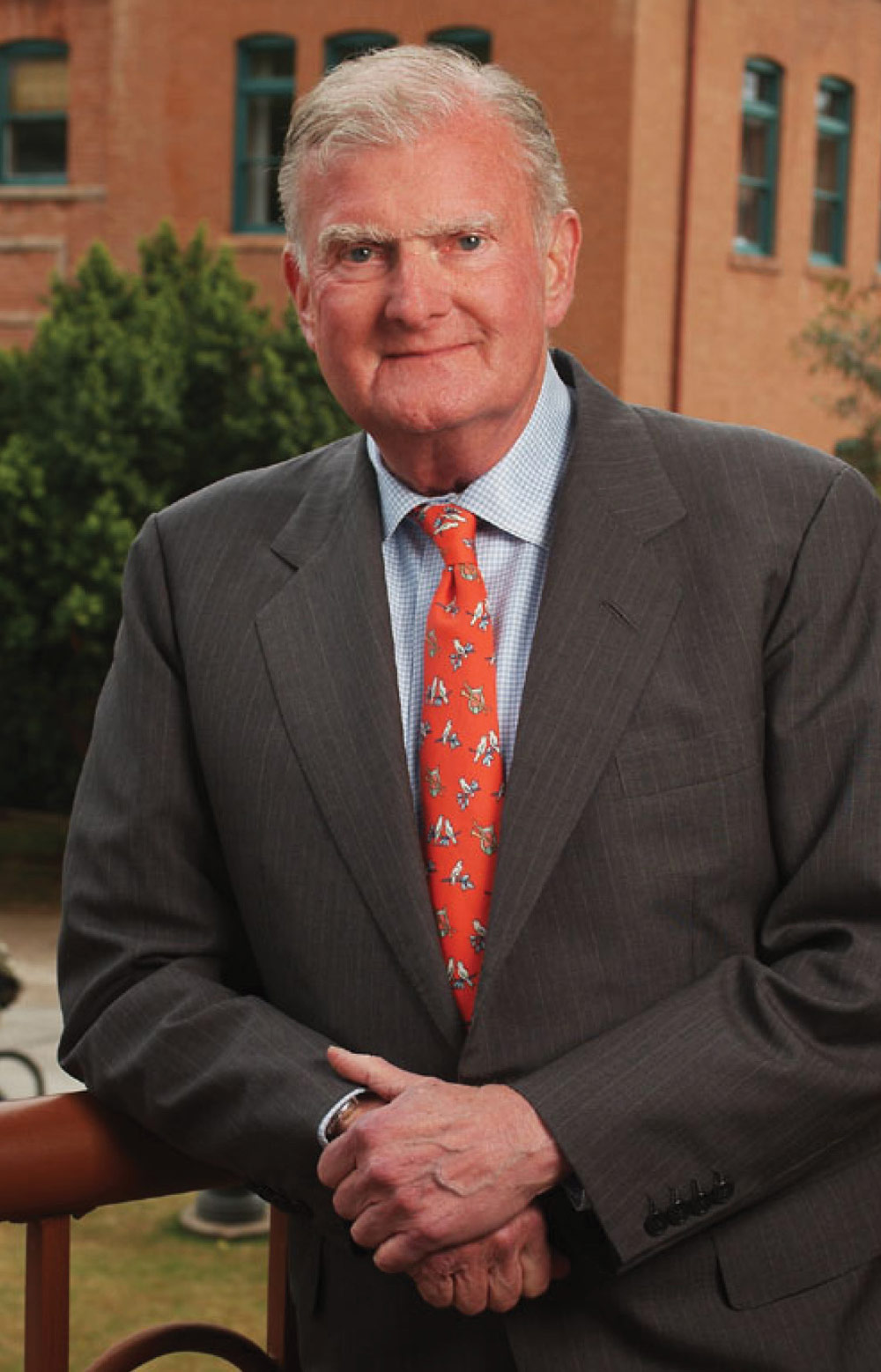
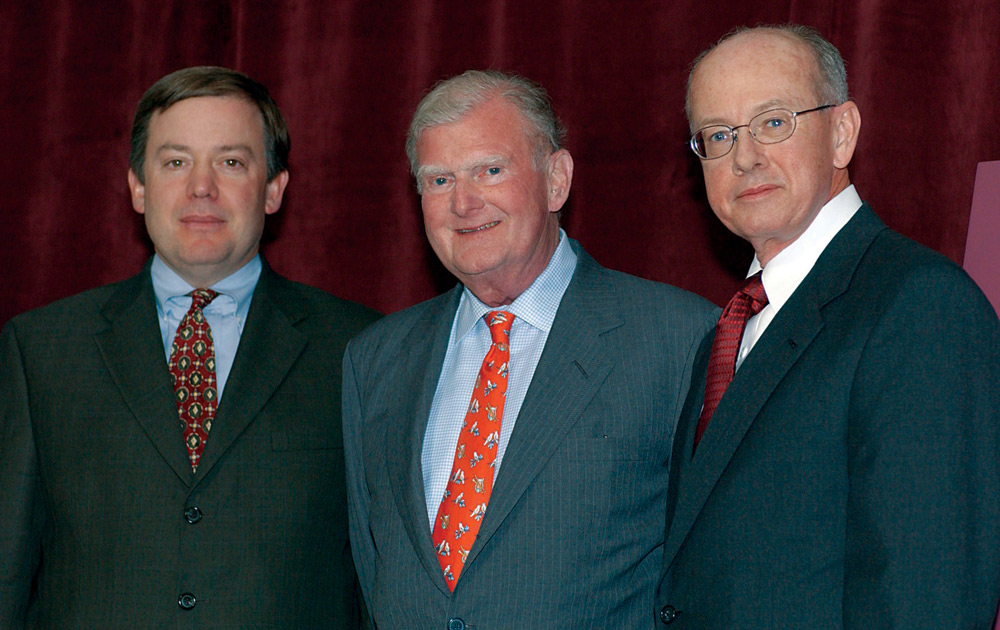
The W. P. Carey School became the only business school offering BS and BA degrees, with an unexpected benefit. Several highly qualified pre-med or pre-law students took advantage of the joint degree programs, further enhancing the school’s reputation.
“The growth was the biggest challenge, in the number of students and in all the different degree programs we were launching,” says Amy Hillman, who became executive dean under Mittelstaedt and dean in 2013. “We needed to balance access, excellence, and innovation. We could never sacrifice excellence, but we knew we had to give more and more people a college degree. For me, the biggest challenge was to keep this positive trajectory going, get it going even faster, and not let anything fall through the cracks.”
Capitalizing on the W. P. Carey Foundation’s philanthropy
Mittelstaedt, who had spent 30 years at the Wharton School and who became dean after Penley left to be president of Colorado State University, pushed to brand the W. P. Carey School and boost its reputation.
The Carey gift was also instrumental in gaining W. P. Carey chairs in accounting, supply chain, economics, marketing, and management. Among them was business cycles expert Edward Prescott, recruited by then economics department chair Arthur Blakemore. Prescott won the 2004 Nobel Prize in economics a year after joining the school.
“You can be competitive financially to attract faculty, but they also like to come to a place where the emphasis is on getting better, accomplishing things, and being part of something,” Mittelstaedt says. He also pointed out that, even though ASU was a state school, it had to have the faculty and programs to compete with private university business schools to be respected and well-ranked.
Funding also went to hiring top junior faculty and adding staffers specializing in business student admissions, advising, and engagement. A career center dedicated to business opened to bring in recruiters and help students land internships and jobs.

The school had a unique role in Crow’s goals. He determined that as a state school, ASU was responsible for becoming more embedded in the community and helping Arizona’s economy grow.
“Arizona State University has a positive impact on our community and our state,” says Steve Evans (BS Management ’67, MBA ’68). “The W. P. Carey business school reflects this ASU commitment, and you will find it embedded as a partner in almost every workforce, economic, and research effort.”
The team expanded the online MBA program and the executive education program, bringing in revenue and strengthening the school’s ties to corporations ranging from John Deere & Co. to General Dynamics Corp. and Mayo Clinic to Knight-Swift Transportation. “The initial development of the online courses in the business school established ‘proof of concept’ that set the stage for the university-wide success of our online programs today,” says Phil Regier, then deputy dean during the transition from Penley to Mittelstaedt.
The school expanded marketing and communications efforts, heralding Carey’s gift in national ads announcing, “East Meets West.” Later, billboards and campaigns such as “Get a Real MBA” attracted prospective students. National marketing initiatives of the school’s well-regarded programs yielded more visibility and respect for the quality of the programs.
“I knew what we had to do,” Mittelstaedt says. “I knew we had to be visible; I knew we had to be top of mind when people said, ‘Name a good business school.’ That is how you’ll get faculty and students to want to come to the place and alumni to want to give funds to support it.”
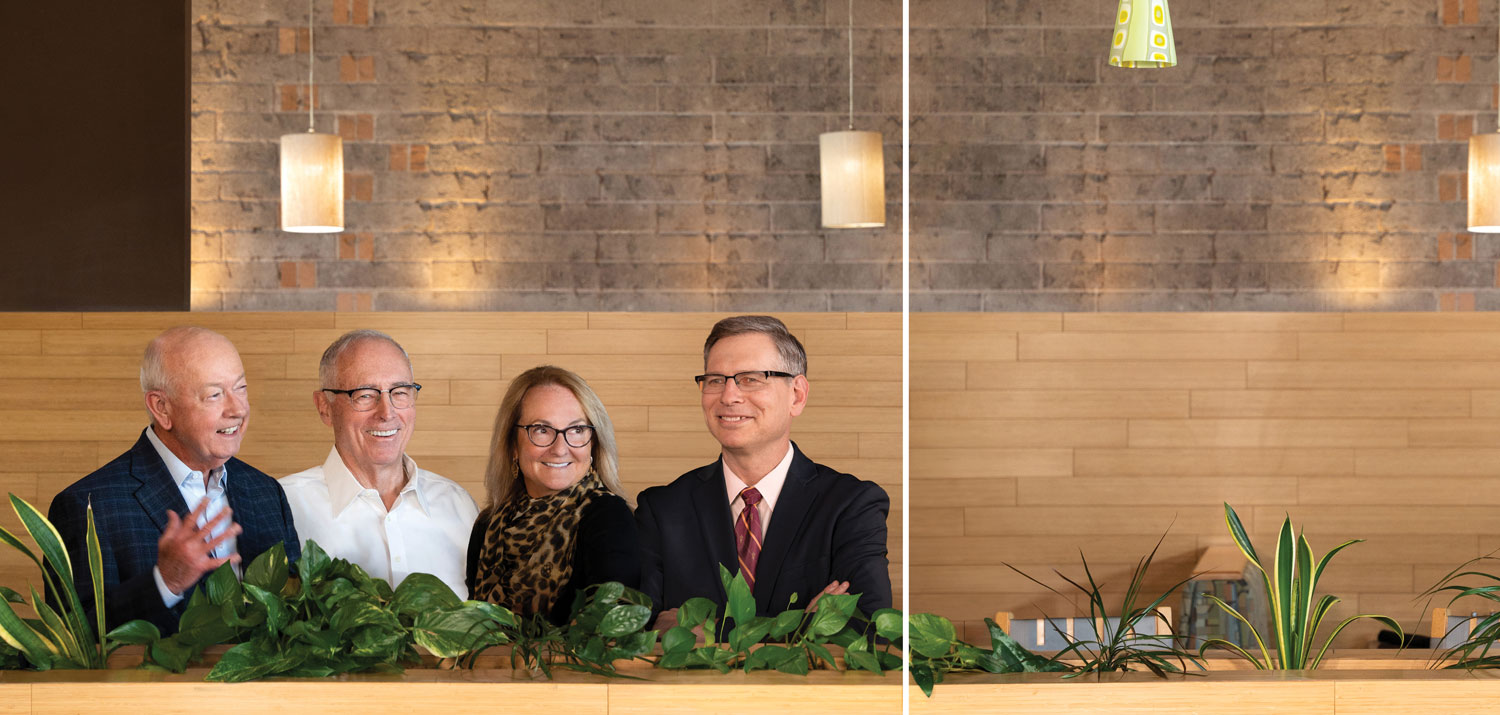
Continuing a legacy
“We have not let them down,” Hillman says. “We’ve continued to honor his legacy and to achieve the things he wanted for us—and to do more than that.” As a result, the school secured an additional $25 million gift commitment from the W. P. Carey Foundation in 2018, which has continued to move it forward.
Changing the culture took many forms. To unite departments and get them thinking of themselves as the W. P. Carey School of Business, the school organized lunches and handed out maroon polo shirts with the W. P. Carey logo. Over time, business programs on the West and Polytechnic campuses were brought under the W. P. Carey umbrella.
Faris and her colleagues pulled out the stops to make students feel part of an intimate place within the large university setting. They revamped first-year orientation and developed learning/living communities for business students on residence hall floors. They started the WPC 101 class to introduce students to business and the Camp Carey weekend to help students adjust and get acquainted. Students with high academic records were selected for the W. P. Carey Leaders Academy, which gave them access to a lounge, faculty advisors, and luncheon events.
Dean of W. P. Carey from 2013 to 2020
Getting a new building to handle the school’s growth and keep pace with technology was another piece of the puzzle. The university helped prioritize it, and Mittelstaedt worked with alums and supporters, ASU, and architects to get the new building that had been a dream for many years.
“Like it or not, people judge an institution’s quality by its physical facilities. A great building also does wonders for internal morale and faculty recruiting,” Mittelstaedt says.
The community gave more than $17 million in donations, including a substantial lead gift from Sharon Dupont McCord and the late Bob McCord, a residential and commercial real estate developer and member of the W. P. Carey School’s Dean’s Council.
“Michael Crow‘s vision of a New American University excited me and Bob, my late husband,” Dupont McCord says. “We were so pleased that McCord Hall would assist in providing world-class learning facilities for great students. It is truly an investment in the future of education.”

Historical Landmarks: 20 Years in the Making











Hillman presided over the opening in 2013.
“McCord Hall was a huge step for the school, especially for someone like me who got their bachelor’s degree in accounting in the old BA building,” recalls Craig Weatherup (BS Accountancy ’67), former CEO of the Pepsi-Cola Company. “We all recognized the next catalyst, the next chapter for W. P. Carey, would rest on securing a world-class facility. To me, McCord Hall was the step that cemented W. P. Carey’s place as an excellent business school in the minds of the business community, with great prospective students, and with those employers seeking our graduates.”
“It allowed us to provide brilliant functionality and advanced technology needed to remain competitive,” says Nguyen, now assistant dean of finance and operations. “To have the presence of McCord Hall to attract top graduate students—when you play in this arena, you need the facilities to show your standing as a business school and accommodate learning for students.”
Steadily, all the work resulted in successes.
With some 20,000 students now, 40 new faculty, and a solid reputation, the school has proved it could do the unexpected.
“We’re the biggest business school in the United States and, I contend, the only accessible business school with the kind of ranking and reputation we have,” Hillman says. “We have proven that scale is not at the expense of quality, that quality and quantity can coexist.”
The success has been evolutionary; the W. P. Carey School has the characteristics of a major business school and high ratings for its undergraduate, online, executive MBA, and other programs.
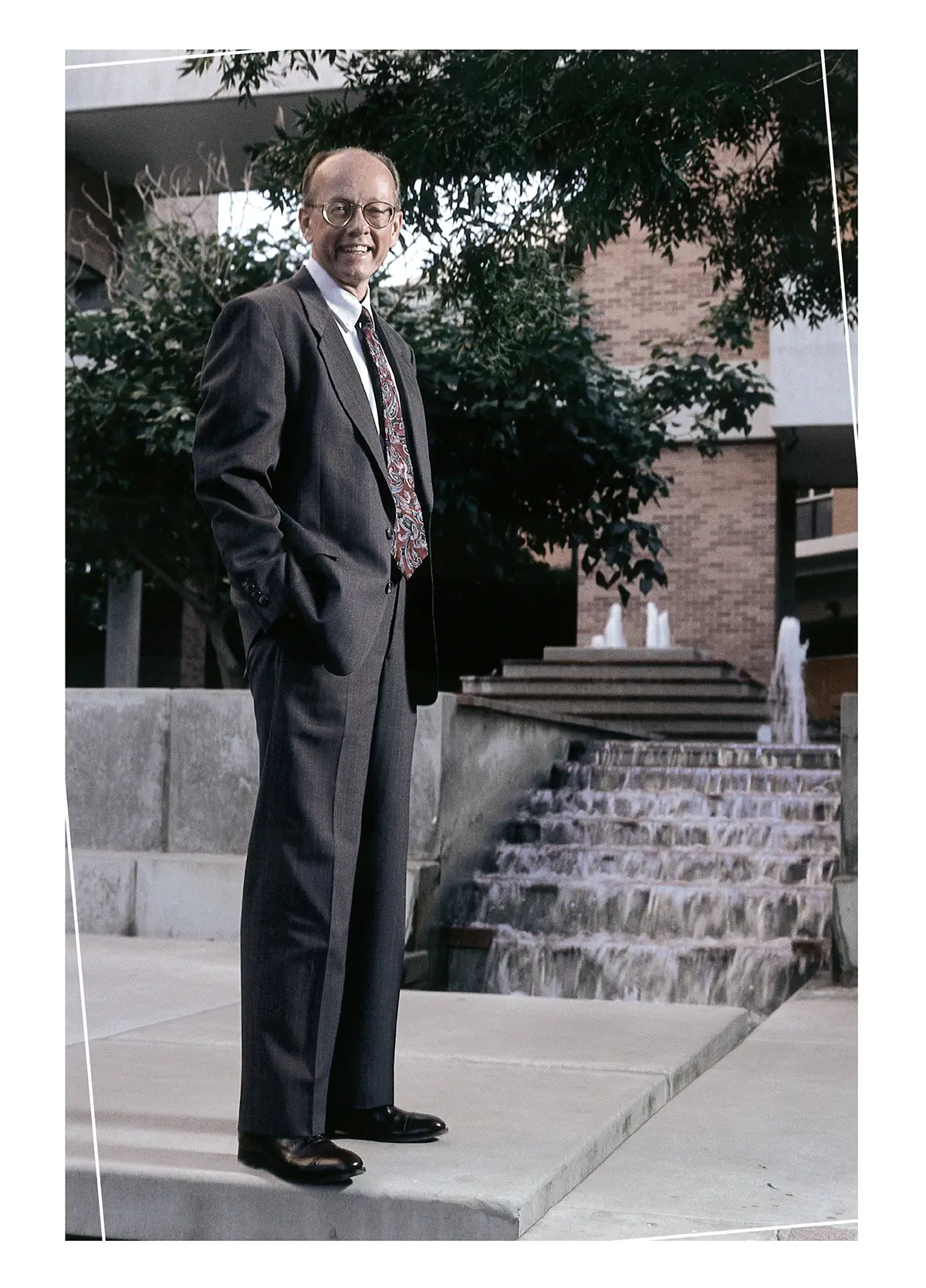
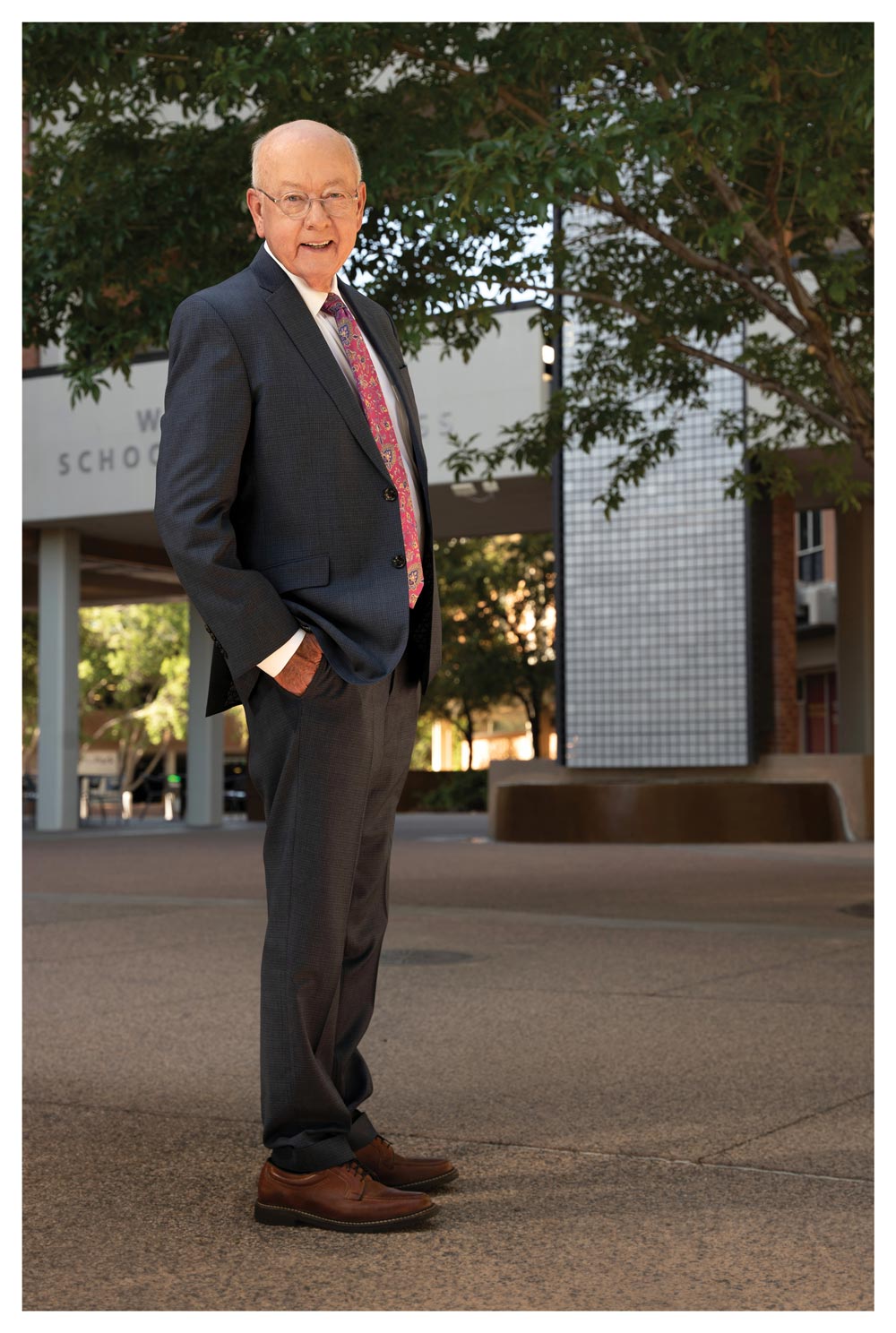
The school weathered the changing MBA market and the Great Recession well. “We marshaled our resources and focused on programs of keen interest, and we could withstand that because we hired high-quality people, in no small part because of that W. P. Carey gift, and good leaders, and maintained those leaders. It’s been a real legacy,” says Hoffman, now director of the L. William Seidman Research Institute at W. P. Carey and ASU’s Office of the University Economist.
The Full-time MBA program hit its highest ranking, No. 22, in U.S. News & World Report in 2008 and remains among the country’s top 35 programs. The Online MBA ranks in the top 10, the Executive MBA in the top 20, the Evening MBA in the top 35, and undergraduate business programs in the top 30.
The school’s successes also include a world-class faculty across multiple departments, stellar staff, a culture of employee respect and support, and CEO-level allies in the business community. The culmination?
“Today, we’re looked at by students as a highly attractive place to study,” says Penley, now regent and chairman for the Arizona Board of Regents. “Not a second choice at all—a first choice.”
The school’s presence has expanded locally, regionally, and globally. The Economic Club of Phoenix and the Dean’s Council are longtime fixtures in the Valley’s business community. The school’s global presence has expanded beyond the China program to include more programs in Asia, an Executive MBA in Mexico, and more study-abroad opportunities for undergraduates.
“Twenty years ago, William Polk Carey committed his name and support to Arizona State University’s vision for a future of expanded access, excellence, and entrepreneurial education,” says Crow. “Today, through the dedicated efforts of many, the W. P. Carey School of Business reflects the aspirational gold standard set by its namesake and continues to grow in distinction as a 21st-century leader in innovation and technology.”
Looking at what’s next
The plan’s initiatives include attracting and retaining top faculty whose research breaks new ground and whose excellence in the classroom increases students’ success. It aims to grow undergraduate and graduate programs, use technology to maximize resources, reach more learners at any stage of their lives or careers, and create new credentials and work/learn programs. It also calls for developing career pathways and improving staff training.
A part of the plan’s initiative included launching a new academic unit this fall—the W. P. Carey School of Technology, Innovation, and Entrepreneurship—on ASU’s West campus (see Introducing the School of Technology, Innovation, and Entrepreneurship to learn more). The new interdisciplinary school supports undergraduate and graduate degree offerings, several research and activity centers, and faculty from various disciplines.
Kadan summed it up in a message announcing the plan: “Our efforts in the next five years will embrace ASU’s commitment to inclusion, advancing research that matters, and helping to improve the well-being of the numerous communities that we serve.”
